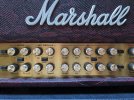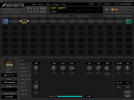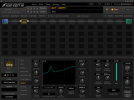Orvillain
Power User
So I and @MirrorProfiles were talking recently. We both feel like the Axe's Satriani JVM doesn't really sound like the real thing. Does anyone else feel this way??
I'm comparing them back and forth, and the Axe version is both fuzzier, seems to have more emphasis on the pick-attack (but in the low frequency region) and isn't as bright as the real amp is, at reasonably stock settings.
For example, here are my real amp settings:

And here are my Axe 3 settings:

They're pretty comparable. Please ignore the 7dB boost on the amp block - I'm just compensating for level differences there, and it doesn't affect the tone of the amp and nothing is clipping anywhere in my chain.
This is what I get when I run pink noise through the real amp and the Axe3:

Now this is obviously just an initial test to try and confirm what I'm hearing when I compare them. The pink line is the real amp, and the white line is the Axe3 JS.
And here are the clips:
Real amp:
Axe3:
I should clarify, I have an IR on each of these. The exact same one. There are no differences in mic position here.
Thoughts??
I'm comparing them back and forth, and the Axe version is both fuzzier, seems to have more emphasis on the pick-attack (but in the low frequency region) and isn't as bright as the real amp is, at reasonably stock settings.
For example, here are my real amp settings:

And here are my Axe 3 settings:

They're pretty comparable. Please ignore the 7dB boost on the amp block - I'm just compensating for level differences there, and it doesn't affect the tone of the amp and nothing is clipping anywhere in my chain.
This is what I get when I run pink noise through the real amp and the Axe3:

Now this is obviously just an initial test to try and confirm what I'm hearing when I compare them. The pink line is the real amp, and the white line is the Axe3 JS.
And here are the clips:
Real amp:
Axe3:
I should clarify, I have an IR on each of these. The exact same one. There are no differences in mic position here.
Thoughts??
Last edited:


